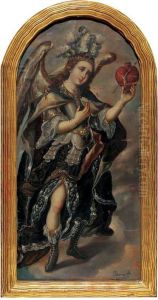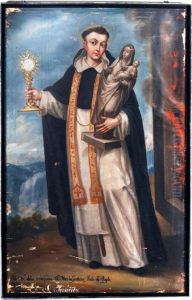Luis Berrueco Paintings
Luis Berrueco was a notable artist active during the 18th century, primarily within the viceroyalty of New Spain, an area that encompasses modern-day Mexico and parts of the southwestern United States. Details about his birth and death are scarce, as is common with many artists of his era, especially those working in the colonies. His work, however, has garnered attention for its representation of religious themes and its role in the development of Mexican art during the colonial period.
Berrueco is often associated with the Puebla school, a prominent art movement in New Spain characterized by its unique blend of European and indigenous artistic elements. This school was particularly known for its religious paintings, altar pieces, and polychrome sculptures that adorned many colonial churches and convents. Berrueco's contributions to this movement are significant, with his works demonstrating a mastery of the European painting techniques of the time, adapted to the local context and themes relevant to the New Spanish society.
His paintings are distinguished by their vivid colors, intricate details, and the incorporation of local flora and fauna, which added a distinct New World character to traditional Christian iconography. Although specific works attributed to Luis Berrueco are not widely documented, his style is consistent with the elaborate and expressive qualities of the Puebla school. These pieces not only served a religious function, promoting the Catholic faith among the indigenous and mestizo populations, but also played a role in the cultural synthesis that defined the colonial period in Mexico.
Despite the lack of detailed biographical information, Luis Berrueco's legacy in the realm of colonial art is preserved through the stylistic influences he contributed to the Puebla school and the broader artistic heritage of Mexico. His work reflects the complexities of colonial society, showcasing the fusion of European and indigenous artistic traditions that characterized the era. Through his contributions, Berrueco remains an important figure in the study of Mexican colonial art, offering insights into the cultural and religious life of New Spain during the 18th century.

